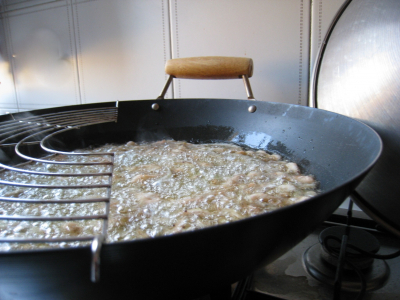The definition of smoke point
Nowadays, the concept of smoke point is considered outdated, but in the past, it was considered a key parameter for frying, and despite everything, it is still taken into account. But what exactly is it? And what are the best oils for cooking?

In Friggere bene, a book published in Italy by Tecniche Nuove that I wrote with chef Giuseppe Capano, I devoted many pages to this topic, because people often talk about the smoke point of oils without really knowing what it is.
 I therefore asked many specialists for their opinion, including the late Professor Bruno Berra, a biochemist of international fame, nutritionist Samantha Biale, another biochemist, Dr. Massimo Cocchi, Professors Natale Giuseppe Frega and Giovanni Lercker, and Dr. Francesco Visioli. The book is definitively worth reading, since it is a source of valuable information. Frying deserves to be tackled more seriously.
I therefore asked many specialists for their opinion, including the late Professor Bruno Berra, a biochemist of international fame, nutritionist Samantha Biale, another biochemist, Dr. Massimo Cocchi, Professors Natale Giuseppe Frega and Giovanni Lercker, and Dr. Francesco Visioli. The book is definitively worth reading, since it is a source of valuable information. Frying deserves to be tackled more seriously.
SMOKE POINT FROM A SCIENTIFIC POINT OF VIEW
Bruno Berra, Samantha Biale: The criterion used to verify whether an oil is suitable for frying is its “smoke point”, i.e. the “critical” temperature at which an oil starts to produce smoke, releasing toxic compounds. Every oil has a specific smoke point, which depends on its composition. Apart from refined palm oil, which has an extremely high smoke point (240° C) and for this reason is often used in industrial production processes, the best cooking oil is without doubt extra virgin olive oil, because it mainly consists of oleic acid and is therefore extremely heat resistant. Its smoke point is around 210° C.
If one considers that when frying at home, the temperatures employed range around 150-160 degrees, one can see that there is a very large safety margin. Moreover olive oil contains high levels of vitamin E and polyphenols, and these antioxidants exert a protective action against the degradation processes taking place during frying which are caused by the presence of oxygen.
We should also consider that like olive oil, palm oil is also extracted from fruits, and therefore contains powerful antioxidants, which are necessary to effectively protect the oil present inside the fruit from all oxidation processes triggered by environmental factors. These antioxidants, called tocotrienols, are much more active than vitamin E and possess remarkable health-promoting properties (8,9).
Massimo Cocchi: Smoke point can be defined as follows: it is the temperature at which a fatty compound, when heated, starts to decompose (hydrolysis) altering its molecular structure and forming acrolein, a toxic compound that has also been found to be carcinogenic. The changes that occur in the composition of the oil depend on many factors, the most important of which are temperature, cooking time, and surface area in contact with the air.
Extra virgin olive oil has one of the highest smoke points among all cooking oils (ca. 210° C). For health reasons and from a chemical point of view it is therefore ideal for frying.
Natale Giuseppe Frega: From a chemical point of view, the smoke point of an oil or fat depends on its fatty acid composition and can be defined as the temperature at which these compounds are hydrolysed and the oil starts to decompose. At this temperature, the molecular structure of the fatty fraction undergoes alterations with the subsequent production of acrolein, a compound that many investigations have revealed to be toxic and carcinogenic. The greater the amount of unsaturated fatty acids in the oil, the lower its smoke point. Extra virgin olive oil is among the best oils for frying thanks to its high smoke point, which is the consequence of the high levels of oleic acid, the mono-unsaturated fatty acid that is typical of all oils made from olives.
Giovanni Lercker: All cooking fats and oils, except for butter, which contains roughly 16% water, can resist normal frying temperatures (170-180° C).
Smoke point was a very useful parameter for assessing whether the fats and oils were suitable for frying before more sophisticated analytical techniques became available. It was used to determine the free acidity of a fat or oil together with the volatile compounds released by oxidation processes, which were responsible for the lower temperature at which smoke emerged.
Nowadays it is deemed more important to determine the levels of diglycerides present in the oil, so as to assess the characteristics of the cooked product. These compounds have emulsifying properties and can reduce heat conduction through the formation of foam, resulting in a badly fried product. The level of these compounds increases by repeated heating, and consequently the quality of the fried food worsens. This problem often occurs in delis, large canteens, and at an industrial level.
Francesco Visioli: The smoke one can see emerging from an overly hot frying pan, mainly consists of oxidised molecules released from the oil into the air. The smoke point is the temperature at which smoke starts to emerge from the oil, releasing toxic compounds. The higher the smoke point (which depends on the oil, and not the user) the more we can heat it. Olive oil has a very high smoke point, hence it can be used at higher temperatures, so that the frying time is reduced (this is the technique employed by Asiatic cooks, who in my opinion are the best “fryers” in the world).
To comment you have to register
If you're already registered you can click here to access your account
or click here to create a new account


Comment this news